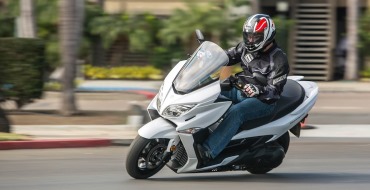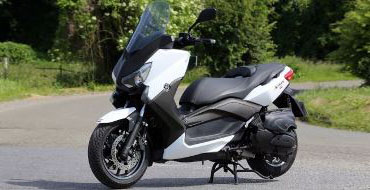 Yamaha XMax YP400RA - Owner's Manual > Checking the brake fluid level
Yamaha XMax YP400RA - Owner's Manual > Checking the brake fluid level
Before riding, check that the brake fluid is above the minimum level mark.
Check the brake fluid level with the top of the reservoir level. Replenish the brake fluid if necessary.
Front brake

- Minimum level mark
Rear brake

- Minimum level mark
Specified brake fluid:
DOT 4
WARNING
Improper maintenance can result in loss of braking ability. Observe these precautions:
- Insufficient brake fluid may allow air to enter the brake system, reducing braking performance.
- Clean the filler cap before removing.
Use only DOT 4 brake fluid from a sealed container.
- Use only the specified brake fluid; otherwise, the rubber seals may deteriorate, causing leakage.
- Refill with the same type of brake fluid. Adding a brake fluid other than DOT 4 may result in a harmful chemical reaction.
- Be careful that water or dust does not enter the brake fluid reservoir when refilling. Water will significantly lower the boiling point of the fluid and may result in vapor lock, and dirt may clog the ABS hydraulic unit valves.
NOTICE
Brake fluid may damage painted surfaces or plastic parts. Always clean up spilled fluid immediately.
As the brake pads wear, it is normal for the brake fluid level to gradually go down. A low brake fluid level may indicate worn brake pads and/or brake system leakage; therefore, be sure to check the brake pads for wear and the brake system for leakage. If the brake fluid level goes down suddenly, have a Yamaha dealer check the cause before further riding.
Changing the brake fluid
Have a Yamaha dealer change the brake fluid at the intervals specified in the periodic maintenance and lubrication chart. In addition, have the oil seals of the master cylinders and calipers as well as the brake hoses replaced at the intervals listed below or whenever they are damaged or leaking.
- Oil seals: Replace every two years.
- Brake hoses: Replace every four years.
Checking and lubricating the cables
The operation of all control cables and the condition of the cables should be checked before each ride, and the cables and cable ends should be lubricated if necessary. If a cable is damaged or does not move smoothly, have a Yamaha dealer check or replace it. WARNING! Damage to the outer housing of cables may result in internal rusting and cause interference with cable movement. Replace damaged cables as soon as possible to prevent unsafe conditions.
Recommended lubricant:
Yamaha cable lubricant or other suitable cable lubricant
Checking and lubricating the throttle grip and cable
The operation of the throttle grip should be checked before each ride. In addition, the cable should be lubricated by a Yamaha dealer at the intervals specified in the periodic maintenance chart.
The throttle cable is equipped with a rubber cover. Make sure that the cover is securely installed. Even though the cover is installed correctly, it does not completely protect the cable from water entry. Therefore, use care not to pour water directly onto the cover or cable when washing the vehicle. If the cable or cover becomes dirty, wipe clean with a moist cloth.
Lubricating the front and rear brake levers
Front brake lever

Rear brake lever

The pivoting points of the front and rear brake levers must be lubricated at the intervals specified in the periodic maintenance and lubrication chart.
Recommended lubricant:
Silicone grease
Checking and lubricating the centerstand and sidestand

- Sidestand

- Centerstand
The operation of the centerstand and sidestand should be checked before each ride, and the pivots and metal-tometal contact surfaces should be lubricated if necessary.
WARNING
If the centerstand or sidestand does not move up and down smoothly, have a Yamaha dealer check or repair it. Otherwise, the centerstand or sidestand could contact the ground and distract the operator, resulting in a possible loss of control.
Recommended lubricant:
Lithium-soap-based grease
Checking the front fork
The condition and operation of the front fork must be checked as follows at the intervals specified in the periodic maintenance and lubrication chart.
To check the condition
Check the inner tubes for scratches, damage and excessive oil leakage.
To check the operation
1. Place the vehicle on a level surface and hold it in an upright position.
WARNING! To avoid injury, securely support the vehicle so there is no danger of it falling over.
2. While applying the front brake, push down hard on the handlebars several times to check if the front fork compresses and rebounds smoothly.

NOTICE
If any damage is found or the front fork does not operate smoothly, have a Yamaha dealer check or repair it.
Checking the steering
Worn or loose steering bearings may cause danger. Therefore, the operation of the steering must be checked as follows at the intervals specified in the periodic maintenance and lubrication chart.
1. Place the vehicle on the centerstand.
WARNING! To avoid injury, securely support the vehicle so there is no danger of it falling over.
2. Hold the lower ends of the front fork legs and try to move them forward and backward. If any free play can be felt, have a Yamaha dealer check or repair the steering.

Checking the wheel bearings

The front and rear wheel bearings must be checked at the intervals specified in the periodic maintenance and lubrication chart. If there is play in the wheel hub or if the wheel does not turn smoothly, have a Yamaha dealer check the wheel bearings.
Battery

- Positive battery lead (red)
- Negative battery lead (black)
- Battery
The battery is located behind panel D.
This model is equipped with a VRLA (Valve Regulated Lead Acid) battery.
There is no need to check the electrolyte or to add distilled water. However, the battery lead connections need to be checked and, if necessary, securely tightened.
WARNING
Electrolyte is poisonous and dangerous since it contains sulfuric acid, which causes severe burns. Avoid any contact with skin, eyes or clothing and always shield your eyes when working near batteries. In case of contact, administer the following FIRST AID.
- EXTERNAL: Flush with plenty of water.
- INTERNAL: Drink large quantities of water or milk and immediately call a physician.
- EYES: Flush with water for 15 minutes and seek prompt medical attention.
Batteries produce explosive hydrogen gas. Therefore, keep sparks, flames, cigarettes, etc., away from the battery and provide sufficient ventilation when charging it in an enclosed space.
KEEP THIS AND ALL BATTERIES OUT OF THE REACH OF CHILDREN.
To charge the battery
Have a Yamaha dealer charge the battery as soon as possible if it seems to have discharged. Keep in mind that the battery tends to discharge more quickly if the vehicle is equipped with optional electrical accessories.
NOTICE
To charge a VRLA (Valve Regulated Lead Acid) battery, a special (constant- voltage) battery charger is required.
Using a conventional battery charger will damage the battery.
To store the battery
1. If the model will not be used for more than one month, remove the battery, fully charge it, and then place it in a cool, dry place.
NOTICE: When removing the battery, be sure the key is turned to "OFF", then disconnect the negative lead before disconnecting the positive lead.
2. If the battery will be stored for more than two months, check it at least once a month and fully charge it if necessary.
3. Fully charge the battery before installation. NOTICE: When installing the battery, be sure the key is turned to "OFF", then connect the positive lead before connecting the negative lead.
NOTICE
Always keep the battery charged.
Storing a discharged battery can cause permanent battery damage.
See also:
 Yamaha XMax YP400RA - Owner's Manual > Air filter elements and check hoses and V-belt case air filter element
Yamaha XMax YP400RA - Owner's Manual > Air filter elements and check hoses and V-belt case air filter element
The air filter elements and the V-belt case air filter element should be serviced at the intervals specified in the periodic maintenance and lubrication chart. Service all air filter elements more frequently if you are riding in unusually wet or dusty areas.
 Yamaha XMax YP400RA - Owner's Manual > Replacing the fuses
Yamaha XMax YP400RA - Owner's Manual > Replacing the fuses
The fuse box, which contains the fuses for the individual circuits, is located behind panel C. TIP The main fuse, which is in a different and hard-to-reach location, must be replaced by a Yamaha dealer. Main fuse Spare main fuse








